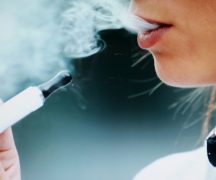By JAN LARSON McLAUGHLIN
BG Independent News
Dr. Nicole Labor wants people to understand that addiction is a disease not a choice.
In spite of the science, some people refuse to think of addictions as anything other than moral weaknesses, she said.
Labor puts it like this – if a person with diabetes chooses to eat a big slice of chocolate cake, then crashes a car, people express sympathy. But if an addict does drugs then crashes a car, “there’s a peanut gallery talking about how the world is better without them,” she said.
“People do not understand the disease of addiction,” said Labor, who is board certified in family medicine and addiction, and a reformed addict herself for the last 18 years.
Labor, from Akron, presented her talk on “The Addictoholic Deconstructed: Addiction 101” last week at the Wood County Educational Service Center in Bowling Green.
In the 1960s, researchers found that mice learned to hit levers that would administer stimulants to their middle brain. Once their brains experienced those stimulants, the mice stopped eating and only focused on continually hitting the lever.
For some humans, the process is much the same. Labor likened it to a person being without water in the desert. After five days, the person would give up their children, home, job, anything for a bottle of water.
The middle brain knows that water is necessary for survival. In the case of addictions, the middle brain is telling the person they need the drug or they will die.
Some who believe addiction is a moral choice point to people they know who have kicked their habits without help.
“You just need willpower,” Labor said. “Uncle Marty gave up crystal meth after 10 years.”
But Labor countered that many people – like Uncle Marty – lack the addiction gene.
“If you are able to just stop – then you aren’t addicted,” she said.
Addiction is the loss of control, overwhelming cravings, and persistent drug use despite negative consequences.
Labor stressed the need to look at the overall problem of addiction – not one particular drug like opioids.
In the 1980s it was cocaine, followed by Sudafed meth, then bath salts, then opiates, and now back to a new kind of meth.
“We keep focusing on specific drugs instead of focusing on addiction,” Labor said.
She compared drug addiction prevention efforts as playing the Whac-A-Mole game. While the focus is on beating down one drug, others keep popping up.
“How do we unplug the machine and turn it off all together?” she said.
Labor explained that the midbrain in some people gets dopamine – a pleasure neurotransmitter – from drugs like cocaine. The reward center of the midbrain then seeks that pleasure in other drugs if cocaine is not available.
Pleasure is necessary for human survival, she said. Addictive drugs lead to the brain needing more dopamine to feel pleasure, and the drugs replace previous sources of enjoyment like family, music, work, hobbies.
Sometimes the craving is so strong, addicts feel they have “no choice in the matter,” Labor said. Their brains rationalize drug use and justify their behaviors to get it.
Guilt and shame often add to the trauma when addicts have to lie, cheat and steal. The brain is telling them, “I know it’s wrong, but I need these,” Labor said.
That leads to a “violent and vicious feedback loop” as addicts need more drugs to get past their guilt, she said.
Labor stressed that compassion works far better with addicts than punishment. While jail time allows an addict to go for a period without drugs, it does not teach them how to stay clean.
Addicts must find purposes in life that don’t involve drugs, she said.
“Without that, people cannot stay clean from addictions,” she said. “They have no coping skills. They reach for the same path that was there five years ago” prior to going to jail.
Relapse often occurs when people are under stress or when they are exposed to their old drug cues, such as the people, places and things that remind them of doing drugs.
Treatment must address the most acute medical issues first, then detox, then quiet the midbrain through abstinence or medication, then restoring the cortex with a new skill set.
Though Labor is not a fan, in some cases medication – rather than abstinence – is needed to cure a chemical addiction. It’s important, she said, that purists not get hung up on treating a drug addiction with a drug.
Otherwise, “they die while we stand on our soapbox of righteousness.”
The keys to treatment include creating coping skills, stress relief, a safe environment, social supports, spiritual growth and personal development.
Treatment should also include pushing the addict to return to previously enjoyable behaviors – hobbies, work, places – to send dopamine into the brain from other sources than drugs or alcohol.
Since addiction is a chronic disease, treatment should be ongoing.
“So anytime along their path, we can catch them if they fall,” Labor said.
While individual counseling is helpful, it is not enough on its own.
“Even the best counselor can’t out-manipulate an active using addict,” Labor said. She recommended 12-step programs, since most addicts can’t fool other addicts.
Too often, treatment programs see the ultimate success as abstinence alone.
“We hold the bar so low for addicts,” she said. Treatment needs to help people thrive beyond their abstinence.
Labor also believes in treating the addict’s family, since addiction affects the whole family.
“Sleeping with your car keys and credit cards in your pillow case is not normal,” she said of those who have experienced theft from addicted family members.





